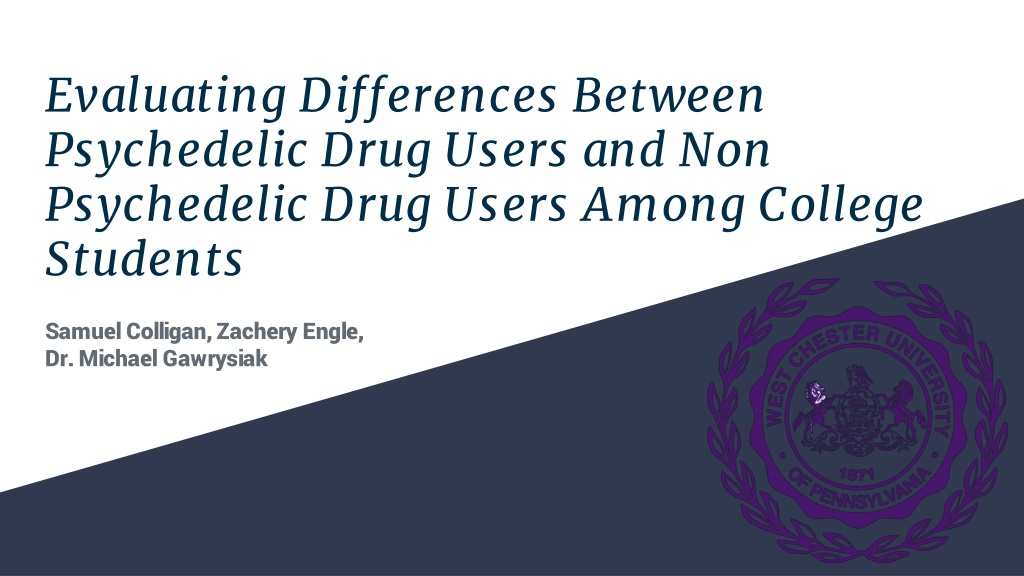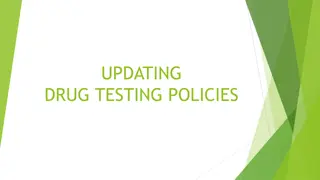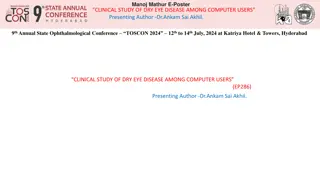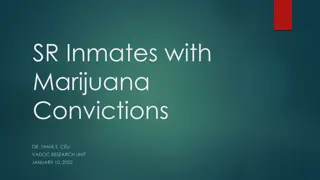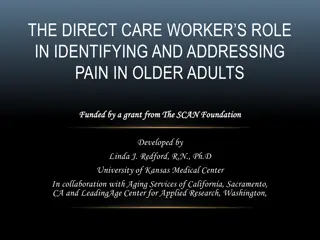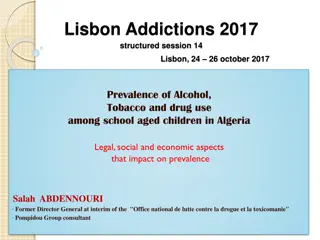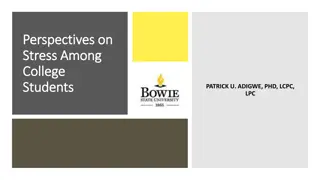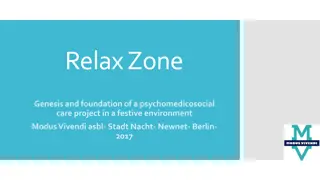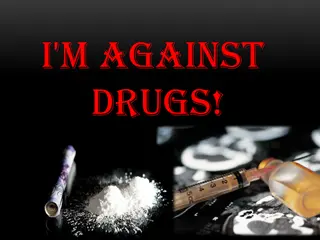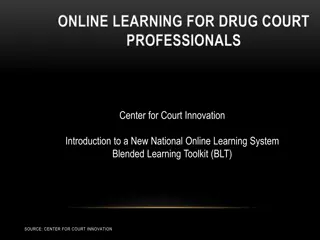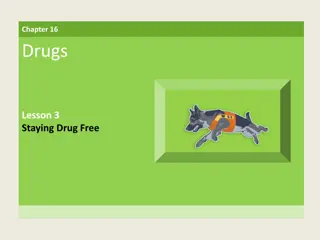Evaluating Differences Between Psychedelic Drug Users and Non-Psychedelic Drug Users Among College Students
This study investigates the differences between college students who use psychedelic drugs and those who do not. It explores the potential therapeutic benefits of psychedelic-assisted therapy, the classification of different psychedelic substances, and the need for research on recreational psychedelic use. The study compares individuals who have used psychedelics with recreational drug/alcohol users, examining factors such as stress, depression, and anxiety. Hypotheses suggest differences in age, stress levels, GPA, and lower depression/anxiety among the psychedelic group. Various measures including the DASS-21, CUDIT-R, AUDIT, and RT-18 are employed in the study.
Download Presentation

Please find below an Image/Link to download the presentation.
The content on the website is provided AS IS for your information and personal use only. It may not be sold, licensed, or shared on other websites without obtaining consent from the author. Download presentation by click this link. If you encounter any issues during the download, it is possible that the publisher has removed the file from their server.
E N D
Presentation Transcript
Evaluating Differences Between Psychedelic Drug Users and Non Psychedelic Drug Users Among College Students Samuel Colligan, Zachery Engle, Dr. Michael Gawrysiak
Introduction Certain psychedelic substances (e.g., LSD, psilocybin) have been tested more frequently for therapeutic applications. Emerging research suggests potential therapeutic benefits of psychedelic assisted therapy: Psychedelic assisted therapy: therapist guided process under a specific substance (e.g., LSD, psilocybin, ibogaine, MDMA) over a few sessions which vary in amount of sessions dependant on the psychedelic, which also include non-drug sessions before and after the experience. (Schenberg, 2018) Psychedelics are serotonergic agonist compounds that occasion an altered state of consciousness. Certain psychedelics are classified as classical psychedelics such as LSD, psilocybin, mescaline, and DMT, and other psychedelic substances like MDMA can be considered non-classical psychedelics.(Mithoefer et al., 2019)
Introduction Cont. Background Information: In order for a psychedelic compound to be deemed a safe substance for the public by the FDA(Food and Drug Administration), three phases of trials need to be fulfilled that demonstrate the efficacy of the drug. While there are several phase two pooled trial analysis for several different compounds of psychedelics, there is not a sufficient amount of research pertaining to recreational use of psychedelics. Keeping in mind that these clinical results are highly encouraging and significant, we need to investigate how people use psychedelic drugs under a recreational setting.
Present Study The present study used a dataset collected from a sample of undergraduate students that completed an assessment evaluating drug and alcohol use and mental health variables with a restricted focus to individuals who reported drug use (i.e., drugs and alcohol). Comparisons: 38 participants endorsed prior use of psychedelics. These participants were compared to recreational drug/alcohol users that do not endorse psychedelic use. This group was comprised of 50 participants that were matched on age, sex, and ethnicity. Group comparisons examine differences between stress, depression, anxiety.
Present Study Hypothesis: Psychedelic group showing a significant difference in age, stress, and GPA as well as lower levels of depression and anxiety compared to the Recreational group. Measures: Depression and Anxiety Stress Scale(DASS-21; Lovibond & Lovibond, 1995) 21 item self report measure assessing depression, anxiety, and stress. The Cannabis Use Disorders Identification Test-Revised (CUDIT-R; Adamson et al., 2010) 8 item screening tool that assesses cannabis use and related problems associated with cannabis use. Alcohol Use Disorders Identification Test (AUDIT; Fleming et al., 1991) 10 item screening tool used to assess drinking behaviors, alcohol consumption, and alcohol related problems. The RT-18 Risk Taking Questionnaire (RT-18; de Haan et al., 2011) A self-report screening tool assessing risk-taking behavior across two risk-factors: risk assessment and level of risk- taking behavior.
Results Table 1 : Demographics Psychedelic Group Non Psychedelic Group Age m=19.53 SD: 1.409 m=19.72 SD=1.457 Race Asian/asian american: 5.3% (2) Black or african american: 2.6% (1) Hispanic or latino: 10.5% (4) White: 76.3% (29) Other: 5.3% (2) Asian/asian american: 6% (3) Black or african american: 4% (2) Hispanic or latino: 10% (5) White: 76% (38) Other: 4% (2) Sex Male:47.4% (18) Female:52.6% (20) Male:42% (21) Female:58% (29) GPA m=3.28 SD:0.561 m=3.38 SD:0.447
Results Cont. Table 2: Comparisons Psychedelic Group Non Psychedelic Group Sig Diffs DASS-21 Depression Anxiety Stress m=6.625 SD:5.278 m=6.750 SD:4.579 m=6.603 SD:4.673 m=4.000 SD:4.046 m=4.080 SD:3.422 m=4.920 SD:4.085 t(53.879)= 2.398, p=.020 t(52.845)=2.831, p=.007 t(59.699)=1.670, p=.100 m=11.970 SD:7.659 m=2.640 SD:3.613 CUDIT-TOTAL t(41.504)= 6.535, p<.001 AUDIT-TOTAL m=9.932 SD:7.603 m=7.620 SD:4.485 t(48.632)= 1.595, p=.117 Total Risk Taking Behavior m=5.784 SD:2.658 m=4.602 SD:2.683 t(78.056)= 2.033, p=.045 m=3.919 SD:2.241 m=2.979 SD:1.831 Total Risk Assessment t(68.419)= 2.079, p=.041
Results Overview No significant statistical differences were observed in variables between the Psychedelic and Recreational groups on age, stress, or GPA. No Significant statistical differences were observed between the Psychedelic and Recreational groups on alcohol consumption or stress. The Psychedelic group showed significantly higher levels of cannabis usage, depression and anxiety (p < .05).
Discussion & Implications Result Inferences: According to the results from this study, polysubstance abuse of psychedelics with other drugs may lead to worse outcomes. However, these are polysubstance users, therefore no signs of intention or motives can be evaluated for psychedelic use. These results are correlational, and do not suggest causation. Future Research: More research would be required on people using psychedelics only in a recreational setting. Motives for psychedelic use could also be assessed in order to solidify for accurate interpretations of the data.
References Adamson SJ, Kay-Lambkin FJ, Baker AL, Lewin TJ, Thornton L, Kelly BJ, and Sellman JD. (2010). An Improved Brief Measure of Cannabis Misuse: The Cannabis Use Disorders Identification Test Revised (CUDIT-R). Drug and Alcohol Dependence, 110:137-143 Fleming, M. F., Barry, K. L., & Macdonald, R. (1991). The alcohol use disorders identification test (AUDIT) in a college sample. International Journal of the Addictions, 26(11), 1173-1185. Lovibond, S.H. & Lovibond, P.F. (1995). Manual for the Depression Anxiety & Stress Scales. (2nd Ed.) Sydney: Psychological Foundation. Mithoefer, M.C., Feduccia, A.A., Jerome, L. et al. MDMA-assisted psychotherapy for treatment of PTSD: study design and rationale for phase 3 trials based on pooled analysis of six phase 2 randomized controlled trials. Psychopharmacology 236, 2735 2745 (2019). https://doi.org/10.1007/s00213-019-05249-5 Schenberg EE (2018) Psychedelic-Assisted Psychotherapy: A Paradigm Shift in Psychiatric Research and Development. Front. Pharmacol. 9:733. doi: 10.3389/fphar.2018.00733 Verster, J., Haan, L. D., Kuipers, E., Kuerten, Y., Laar, M. V., & Olivier, B. (2011). The RT-18: A new screening tool to assess young adult risk- taking behavior. International Journal of General Medicine, 575.
